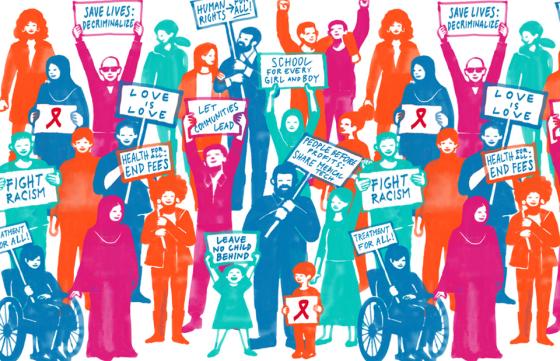Liberia: Ending AIDS by 2030 – Are we on track?

Each year, 1st December is celebrated by the Global Health Community as World AIDS Day (WAD) - a day set aside to bring together people from around the world to raise awareness about HIV/AIDS and demonstrate international solidarity in the face of the pandemic.
The day also presents an opportunity for public and private partners to provide awareness about the status of the pandemic and encourage progress in HIV/AIDS prevention, treatment, and care around the world. It has become one of the most widely recognized international health days and a key opportunity to raise awareness, commemorate those who have died, and celebrate victories such as increased access to treatment as a prevention strategy.
The global theme for this year's WAD is EQUALIZE. The effort to equalize is meant to focus, and address the inequalities which are holding back progress towards ending AIDS; and equalize access to essential HIV services, particularly for children and key populations and their partners - men who have sex with men, people who use drugs, sex workers, and people in prisons. Known public health approaches encourage programs to recognize the needs of ALL vulnerable sub-populations with the manifest risk of being infected with HIV/AIDS.
It is no gain saying that the current and persistent economic, social, cultural and legal inequalities and challenges posed by Ebola and the recent COVID-19 pandemic and other global crisis requires renewed efforts to maintain visibility for HIV and to end AIDS as a public health threat.
The National AIDS and STI Control Program (NACP) under the MOH was established in 1986. Since then, the country has designed actionable programs to reduce the incidence of HIV in the population. The full range of interventions are operable in Liberia, from HIV testing, community-based services, early initiation of anti-retroviral therapy (ART) and decentralization of services to primary health facilities. These efforts have all resulted in improved access to HIV prevention and treatment services across the country.
Additionally, the National AIDS Commission was established in September of 2010 to superintend over the larger multi-sectoral national response to AIDS. Since its establishment, the NAC has led the development of two national strategic plans, (NSP 1 & ll). The two overall goals have been to prevent the further spread of HIV and mitigate the impact of AIDS on society. The goals are expanded specifically to (1) contain the HIV prevalence rate among the general population below 1.5 percent and (2) mitigate the impact of the epidemic on the health and wellbeing of persons infected and affected by HIV/AIDS. These two goals have been further operationalized in five strategic objectives that address the five key intervention areas.
HIV funding has mainly come from international development partners, in particular the Global Fund (GFATM), which contributed almost $7.7 million through Round 2 (as of 2004), and in late 2006, $31.15 million through Round 6. A subsequent proposal under Round 8 was approved in the amount of $77.7 million and started in 2010. My information is that under the current GFATM funding cycle, Liberia intends to submit a concept note (proposal) to the Global Fund for the program years, 2023 – 2025.
While the first program mainly focused on initiating the response, the subsequent rounds of funding comprised major components for strengthening health systems (HSS), to allow for effective delivery of key HIV services by the health and community sectors with a focus on vulnerable at-risk populations, including the prevention-of-mother to child transmission. The UN Joint Program is also committing additional funding for HIV/AIDS.
The HIV/AIDS context in Liberia reflects a low-level generalized epidemic with an estimated 35,000 (29,000–43,000) people living with HIV (PLHIV), corresponding to an estimated prevalence of 1.1 (0.9–1.4) in adults aged 15–49 years. Additionally, there will be about 19,000 people on antiretroviral therapy (ART) in 2020. When compared to rural settings, the prevalence of HIV in urban settings is nearly three times higher, and greater Monrovia where more than a quarter of the Liberian population resides has the highest burden of HIV. (Gray, Kiazolu & others; 2022).
The renewed focus on promoting various prevention interventions now targets addressing the gender dimension of HIV/AIDS, including sexual and gender-based violence in a post-conflict society, and addressing the sexual and reproductive health needs of adolescent girls and young people generally.
Stigma and discrimination are continuing challenges needing attention. Equalizing opportunities across the different HIV communities under a multi-sectoral approach would result in better access to a wider community of people, information, and resources and facilitate rapid program implementation.
Against all of the above, Is Liberia on track towards achieving the goal of ending ADIS by 2030?
Throughout this week and subsequent ones, the expectation is that the NAC and its many partners (civil society and community groups, INGOs and international partners including the UN Joint Program on HIV/AIDS and bilateral partners will update the nation on the status of implementation with a renewed focus on ending AIDS by 2030.
I dare say that achieving the goal of ending AIDS in Liberia by 2030 is well within our reach. Let’s all re-energize our efforts, and with the support and coordinated efforts of the NAC, UNAIDS, and various civil society actors, work hard to equalize opportunities and end AIDS by 2030.
The Author
David Logan is a Policy Analyst. In the past, he has worked at the University of Liberia and the Ministry of Health in Monrovia.
